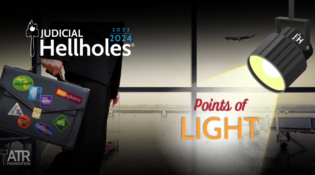Florida continued to make progress towards improving its legal climate in 2020 as a direct result of Governor Ron DeSantis’s (R) thoughtful and decisive leadership, as he continued to remake the Florida Supreme Court through two additional appointments. Florida appears to be a tale of two stories, though, as the legislature stalled in its efforts to pass long-sought, meaningful lawsuit reform. As a result, Florida remains on the Watch List and ATRF will continue to monitor the Sunshine State.

Florida
FLORIDA'S SUPREME COURT CONTINUES TO TAKE SHAPE
In January, 2019, Governor Ron DeSantis (R) replaced three retiring activist justices with three textualists, Barbara Lagoa,  Robert Luck, and Carlos Muñiz. They joined historically conservative justices Charles Canady, Ricky Polston, and Alan Lawson, leading political observers to call the Court the “most conservative Florida Supreme Court in decades.”
Robert Luck, and Carlos Muñiz. They joined historically conservative justices Charles Canady, Ricky Polston, and Alan Lawson, leading political observers to call the Court the “most conservative Florida Supreme Court in decades.”
In September of last year, though, President Trump elevated Justices Lagoa and Luck to the U.S. Court of Appeals for the Eleventh Circuit, giving Governor DeSantis two more opportunities to change the face of Florida jurisprudence. The Governor telegraphed his intentions in his 2020 State of the State address, remarking that Florida’s legal system is supposed to address real injuries and disputes, and not to be used as a game.
Sure enough, Governor DeSantis hit two home runs with the Supreme Court appointments of John Couriel and Jamie Grosshans, two justices who have proven to be restrained in their approach to their role as a judge. Based on his phenomenal selections thus far, reformers can no doubt look forward to more stalwart appointments throughout the judiciary as they become available.
THE FLORIDA LEGISLATURE STALLS IN ITS EFFORTS TO PASS LONG-SOUGHT REFORMS TO THE PERSISTENT LAWSUIT ABUSES
Having finally enacted several reforms in 2019 like assignment of benefits reform and narrowing the dan- gerous instrumentality doctrine, the legislature stumbled in 2020, failing to make much progress on top priority issues.
ONE BRIGHT SPOT ON VICARIOUS LIABILITY
In the one notable victory of the session, the legislature unanimously passed HB 977 to shield motor vehicle dealers from vicarious liability when they provide temporary replacement vehicles, i.e., service loaners. In other words, an auto dealership cannot be sued as a deep pocket when a customer gets into an accident simply because he or she was driving a loaner. While only a small improvement to the overall legal climate, in Florida, every little bit counts.
REFORMS STILL NEEDED
BAD FAITH ON BAD FAITH
Bad faith lawsuits targeting insurers continue to be fertile ground for trial lawyers looking to game the system, but the Florida legislature continued to avoid addressing the larger issues at play for yet another year. This is especially disappointing as more than 80 percent of Floridians think it is unfair that insurance rates rise due to excessive lawsuits and inaccurate claims against insurance companies.
Currently, most often in situations where there is clear liability, substantial damages, and low policy limits, trial lawyers use delay tactics and multi-pronged, impossible-to-satisfy demands to set insurers up for a bad faith action. Legislation introduced in 2020 would have established a “reckless disregard” standard for third- party bad faith lawsuits, and procedures for settling claims with multiple claimants in order to avoid bad faith.
Bad faith lawsuits can result in eye-popping numbers. In just one notable bad faith action, Harvey v. GEICO, the insurer tendered the full $100,000 policy limits nine days after the accident, but was ultimately hit with an $8.47 million judgment. Legislators must address the process that leads to these distorted results or risk jeopardizing the judicial system’s legitimacy.
MULTIPLYING ATTORNEY’S FEES
Attorney fee awards in ordinary insurance disputes are calculated under a so-called “lodestar” fee of the number of hours reasonably expended by the attorney multiplied by his or her hourly rate. Attorneys may also qualify for a “contingency risk multiplier” designed for rare and exceptional circumstances where the lodestar figure does not adequately compensate for a particularly difficult case, or one where it’s hard to obtain capable and willing counsel.
Unfortunately, as the result of the Florida Supreme Court’s decision three years ago in Joyce v. Federated National Insurance Company (prior to Governor DeSantis’s appointments), contingency risk multipliers in Florida are now commonplace. As just one example, in a run-of-the-mill insurance coverage dispute, Santiago v. Florida Peninsula Insurance Co., the Court awarded the plaintiff’s attorney $1.2 million in fees on a $41,000 plaintiff’s award using a 2.0 multiplier. The chance that a court may award a multiplier in any given case is a real risk that’s pushing defendants to pay higher, unreasonable settlements.
The Florida Legislature had an opportunity to pass legislation in 2020 and realign Florida with the federal standard, so that contingency risk multipliers are only awarded in “rare and exceptional” circumstances, but the legislature failed to do so. It should not miss the opportunity again in 2021.
FIXING THE “NO-FAULT” PERSONAL INJURY PROTECTION SYSTEM
The history of fraud in Florida’s “no-fault” personal injury protection (PIP) system has been long chronicled in the Judicial Hellholes report. Under the current PIP system, insurers are required to pay up to $10,000 for medical expenses stemming from auto accidents no matter who is at fault. Florida lawyers and their associates have been abusing the system for years, contributing to why Floridians have some of the highest car insurance rates in the country. Legislators must come together and address the rampant fraud plaguing the system.
INFLATED AWARDS FOR MEDICAL EXPENSES
Plaintiffs’ lawyers have also long abused what are known as “letters of protection” to inflate medical expenses for the purpose of lawsuits. Letters of protection are agreements between a person who needs medical care, his or her lawyer, and a healthcare provider under which the healthcare provider agrees to not seek to collect a fee for medical treatment from the patient, but wait to collect out of an expected settlement or judgment. Letters of protection can serve a legitimate purpose when a person is uninsured and unable to pay for medical expenses. However, some Florida lawyers recommend that their clients not use their insurance to cover medical expenses, but rely on a letter of protection.
Under Florida law, at trial, jurors learn the initially invoiced amount of medical expenses, which is essentially a “sticker price” that is often three or more times the amount that is ultimately accepted by the healthcare provider as full payment. After a verdict, Florida law requires judges to adjust the award to reflect the actual amount of medical expenses paid and accepted, a process called a “set off.” Florida’s personal injury lawyers often use letters of protection to avoid this set off. By avoiding evidence of the actual value of medical treatment, there is no amount paid for a judge to set off the award.
This type of abuse benefits no one but the lawyers and the medical clinics that may be in cohorts with them. The lawyers get to inflate the damage award and collect a larger contingency fee. The medical provider gets paid a rate that is much higher than market value. The plaintiff, however, has these high rates taken from his or her share of the judgment, even if they would have been covered by insurance.
Legislation can ensure that jurors receive accurate information on the actual value of medical expenses and prohibit abuse of letters of protection. The legislature should also revisit the need to place reasonable constraints on subjective and unpredictable noneconomic damage awards, which are particularly important for preserving access to affordable medical care.
TRIAL BAR SETS SIGHTS ON SOUTH FLORIDA - SPENDS MILLIONS ON ADVERTISING
According to a 2020 report, television viewers in South Florida saw approximately 113,000 local legal services advertisements in the third quarter of 2019 (July-September). The lawyers, their firms and others who purchased these local legal services ads spent $13 million during the three-month span.
In addition to the local ads, Florida viewers also were exposed to $71 million worth of national legal services ads. These 45,000 ads were shown on national broadcasts as well as cable networks, as opposed to just airing locally. Approximately 60 percent of those ads solicited claims related to alleged injuries caused by pharmaceutical drugs, medical devices and agricultural products.
To put into perspective how frequently local legal services ads run on Tampa televisions, when compared with ads for clothing stores, they run 13 times as often. When compared with ads for pizza delivery and restaurants around Miami and Ft. Lauderdale, legal services ads run nine times as often.
Several plaintiffs’ firms, including the Florida powerhouse, Morgan & Morgan, received millions of dollars from the COVID-19 federal Paycheck Protection Program. Morgan & Morgan applied for and received $12 million – $27 million in relief from five different states, including Florida. This money was meant to help cover operating expenses including rent and employee salaries and benefits. Meanwhile, during this same time period, the firm increased its lawsuit advertisement spending from approximately $50,000 per day to $300,000 per day.
RETURN TO HELLHOLE STATUS?
South Florida has developed a well-deserved reputation for its aggressive personal injury bar and fraudulent and abusive litigation practices. While the rest of the state has looked to curb litigation abuse, some South Florida judges have allowed it to run rampant. Whether its abuse of letters of protection, assignment of benefits, or bad faith laws – South Florida is ground zero for the state’s litigation problems.
According to a Publix lawyer testifying before the Senate Judiciary Committee, at any given time, there are approximately 450 personal injury claims pending against Publix, most of them in Florida. On average, the cost of settling Publix claims in Florida was 65 percent higher than the cost in any other state in which Publix operates. The cost of settling Publix claims in South Florida was 50 percent higher than the cost in the rest of the state.
While the volume of cases in 2020 was considerably lower because of the courts’ COVID-19 shutdown, if the amount of money spent by the trial bar on advertising is any indication, Florida’s litigation activity will
return to its high levels in 2021. If South Florida refuses to follow the lead set by the rest of the state, and the trial bar continues to have its way, the area may return to its previous status as a Judicial Hellhole.
Latest News

Talc Litigation Takes Another Dramatic Turn
On Wednesday, April 10th, a hearing on a motion to disqualify a prominent plaintiffs’ firm and a lead attorney from
Judicial Hellholes
Previously Debunked Lab at Center of New Litigation
This week plaintiffs filed litigation against Walgreens and Kenvue, among others, in Massachusetts, California and Nevada, alleging that their acne products contain unhealthy amounts
Judicial Hellholes
Philadelphia Judge Restores Some Sanity to Monsanto Litigation
This week, Monsanto scored its first defense verdict in the Philadelphia Court of Common Pleas after a string of astounding
Points of Light
